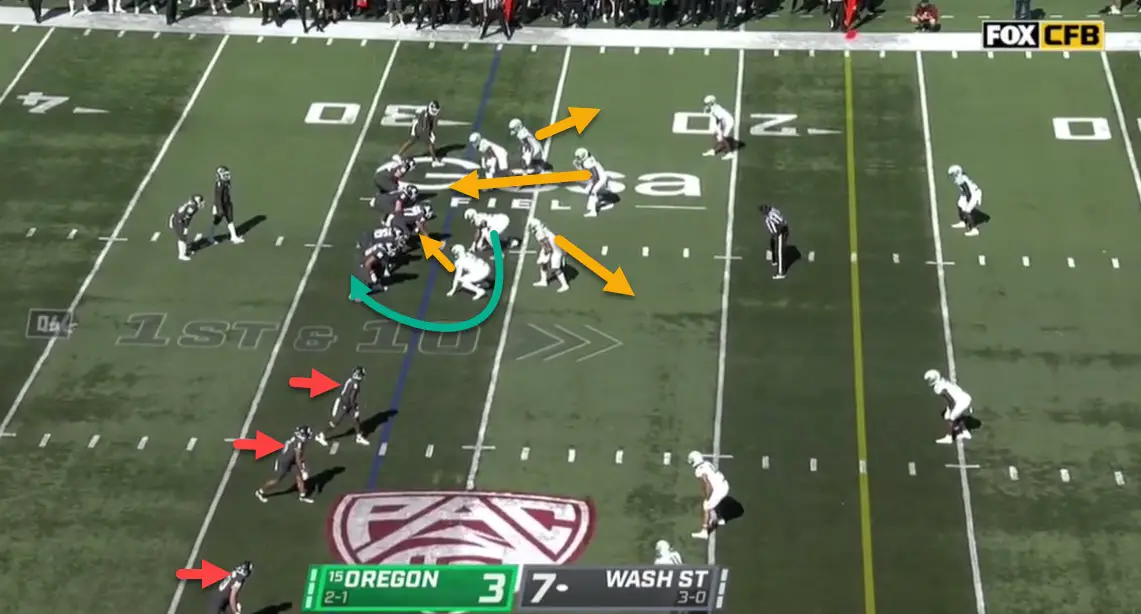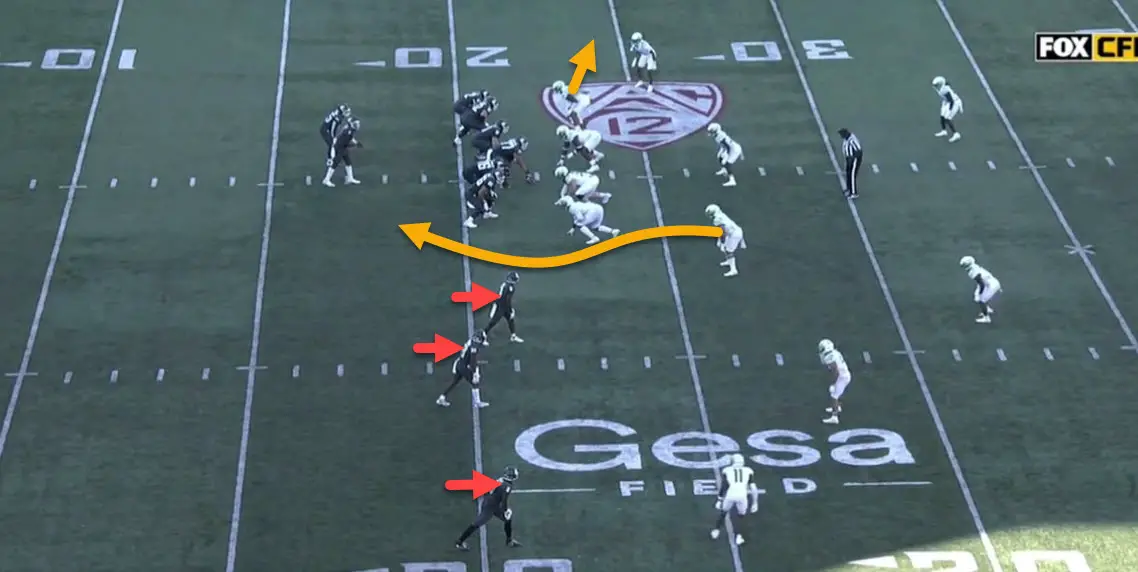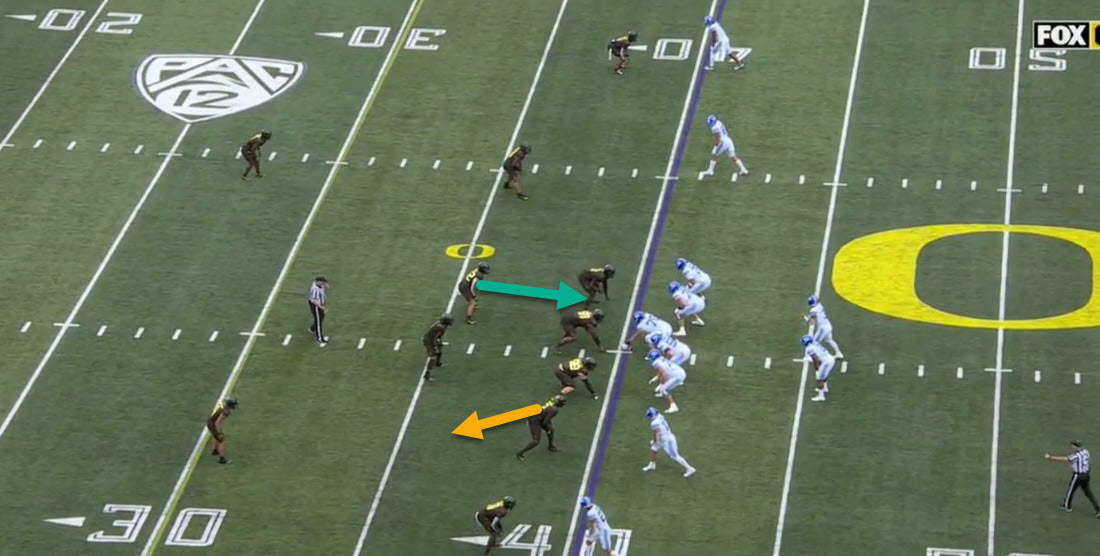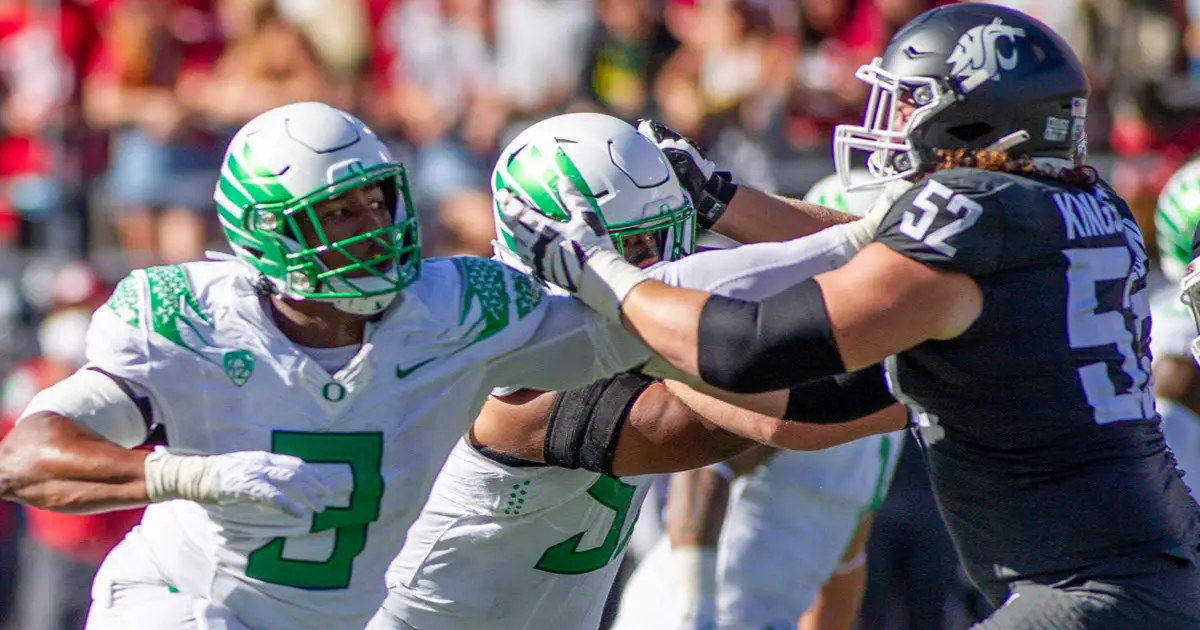Oregon fans were thrilled to learn of the defensive pedigree of new Duck head coach Dan Lanning after leading the Georgia defense to a national championship last year. While most fans would assume there would be a learning curve for Oregon’s defensive players beyond this year, we anticipated seeing more success on defense than what we have thus far this season. It was especially a surprise to me with all the veteran players in the Ducks’ front seven.
In my studies of what Coach Lanning implemented with the Bulldogs, a theme was presented often of how to create pressure on an opposing quarterback with only four rushing. The benefit is the ability to “stay safe” in the secondary with seven defensive backs in different coverage shells due to the non-blitzing alignment of only sending four at the quarterback. But how do you create pressure with only four rushing?
Coach Lanning refers to it as simulated pressures, but 10-12 years ago we called it a “Zone Blitz,” where the defense is sending pass rushers, but the offense does not know from where the pressure is coming. This confusion comes from defenders dropping back into pass coverage after beginning on the line of scrimmage, combined with sending linebackers and even defensive backs at times from different directions to create pressure with just four pass rushers.

A great first example of pressure from just four, coupled with superb coverage in the secondary.
Before we go to the example video below, let’s first examine the screenshot above to know what to watch for. Note how the top two defenders on the line of scrimmage (LOS) above are threatening an overload blitz from our right side, thus the three on the LOS and the stand-up defender in the upper right appear to be “the four” who are rushing. The red arrows point to “trips” receivers on one side, the area of the field the Cougars want to attack.
See how (above) two of those six in the box will drop back into coverage zones in the right and mid-hook area to prevent a “hot” receiver from rescuing the QB as a relief valve. On the left side, we have a twist going on between the defensive end and tackle, as the defensive tackle has a key role (green line/arrow above) in keeping “contain” to Oregon’s left side. This prevents that talented WSU QB from rolling out in that direction, as he planned. Justin Flowe, No. 10, is coming up the middle as the fourth rusher who helps to break the pocket.
The second half of the video above shows the superb coverage downfield, and how defenders deftly trade receivers to cover in mid-route. Oregon stopped the roll-out of the quarterback, and with seven in the defensive backfield, the pressure finally forced the ball to be thrown away. Applying pressure and yet staying safe!
This is a tactic I’ve witnessed often in the first four games of the Lanning era.

Pressure comes from unexpected directions, yet contains the roll-out and forces another throw-away pass.
For the next play in the video below, examine the screenshot above to see the next variation of the “pressure while staying safe” tactic. There are four on the LOS, but the defensive end at the top is going to drop off and cover the running back, who is slipping out of the backfield. Noah Sewell, No. 1, is going to help overload WSU’s right side. The Ducks are only sending four in the pass rush, but it is four against three Cougar blockers on their right side, and another throwaway is created!
Note the trips receivers again (in the video above) on WSU’s right side and how QB Cameron Ward wants to escape that direction to find the open receiver. The technique Sewell uses in staying on the outside shoulder of the offensive tackle and thus keeping “contain” on that WSU right side funnels the QB toward the other Ducks on the rush. An incomplete pass created from superb coverage downfield, and enough pressure from only four rushing to blow up the play!
Oregon’s success with this has been slowly gaining traction, as the players become accustomed to game speed and different blocking schemes.

Sure, you do get a sack, too, with this disguised pressure!
This final example demonstrates how this “safe strategy” can also create a sack of the quarterback. The screenshot above shows how DJ Johnson is lined up to rush at the bottom of the LOS, but he will peel off (yellow arrow above) and cover the running back coming out of the backfield. The fourth rusher will be Jackson LaDuke, No. 42, (green arrow above) and these four Ducks will be taking on five BYU blockers.
Brandon Dorlus, No. 3 above, does a superb job of beating the BYU pass block by No. 78 Kingsley Suamataia (yep, the transfer from Oregon) and snagging the quarterback’s arm, with No. 98 Jordan Riley finishing off the sack! Most would say this is a “coverage sack,” which would confirm again the wisdom of employing this “staying safe” strategy and tilting the play toward Oregon’s personnel strengths.
Like you, I want to see massive overload blitzes and exotic tactics from the new Lanning defense. Oregon is beginning to delve into those, and as they do, we will look at them here and the techniques utilized by the Oregon defenders. But as the Ducks adjust to the Lanning tactics, expect to see “pressure while staying safe” often in many different permutations.
Let’s discuss in the OBD forum because …
“Oh, how we love to learn about Our Beloved Ducks!”
Charles Fischer (Mr. FishDuck)
Eugene, Oregon
Top Photo by Harry Caston

Charles Fischer has been an intense fan of the Ducks, a season ticket holder at Autzen Stadium for 38 years and has written reports on football boards for over 26 years. Known as “FishDuck” on those boards, he is acknowledged for providing intense detail in his scrimmage reports, and in his Xs and Os play analyses. He is single, has a daughter Christine, and resides in Eugene Oregon where he was a Financial Advisor for 36 years.
He now focuses full-time on Charitable Planned Giving Workshops for churches and non-profit organizations in addition to managing his two Oregon Football Websites, of FishDuck.com and the Our Beloved Ducks forum. He is a busy man!
He does not profess to be a coach or analyst, but simply a “hack” that enjoys sharing what he has learned and invites others to correct or add to this body of Oregon Football! See More…

